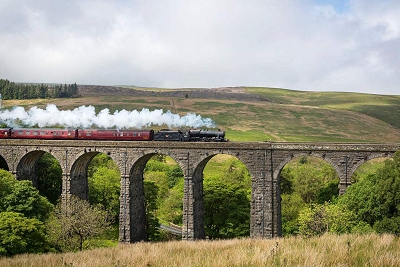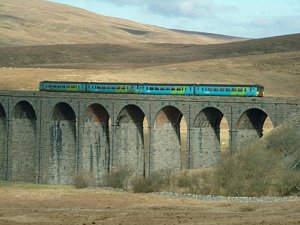He now campaigns for a commemoration of the role of Durranhill, the "beating heart" of the line.

Eric's story:
The Settle-Carlisle line - widely acknowledged as the most scenic railway in England - has run like a thread through my life. In 1952, on my third birthday, my family moved from Wigan to Carlisle. My father George was transferred there by British Rail and became a driver on the West Coast Mainline.
We lived at Petteril Terrace, which used to be Midland Cottages. It was named after the Midland Railway Company, which built the Settle-Carlisle line. The houses were originally for employees of the line, and were now for rail workers in general.
The Settle line ran about 200 yards behind our house. It was steam trains in those days. You could smell the smoke. And they would hiss. In a way, steam trains are alive.
The railway was my adventure playground. There were no fences; you could walk straight in. A gang of us used to play on the line. We were all railway children: everybody's father in the street worked on the railway.
Not far from my house was a turntable, where the engines were turned to go from the line into and out of the nearby Durranhill maintenance sheds. We'd try to push the big levers, pretending to help the fireman push it around. He would give us a lift on the engine's footplate, dropping us off before the sheds. It was exciting, and scary, even though we were only going about half a mile very slowly. I'd do this until I was 11 or 12.
My next involvement with the Settle line was years later. In 1974 I'd been elected to Cumbria County Council. From 1983 to 1985, I was its chairman. In 1983 British Rail declared its intention to close the line on economic grounds. We started the campaign to save it, along with West Yorkshire County Council. Its chair John Gunnell played a prominent role and later became an MP. A council colleague of mine, Bill Cameron, became spokesman for the opposition to the closure and did an excellent job.
The campaign grew legs. There were a lot of community protests. Friends of the Settle-Carlisle Line was set up. Ron Cotton, who British Rail put in charge of closing the line, helped to transform its fortunes and was happy to see it stay open.
I became an MP in 1987. Soon after, I had an adjournment debate on the proposed closure. I'd prepared the customary quarter of an hour's speech. But business collapsed early. Suddenly I had up to an hour and a half to debate the issue. Fortunately Bob Cryer, MP for Bradford South, was a railway enthusiast. So we filled in the time, along with other MPs.
Despite all these efforts, we always thought we were going to lose the line. When a government consults on something, it's very rare that it changes its mind. In 1989 Minister for Transport Michael Portillo came to the House… and announced that the line was to be kept open.

I was the first Labour MP to shake his hand, and I didn't often shake Portillo's hand in those days. He says that saving the Settle-Carlisle line was his most important act in government. The line sparked his passion for railways, leading to him travelling the world with his railway documentaries and transforming him into a national treasure. It was his rail ticket to Damascus!
In 2009 I put down an Early Day Motion celebrating 20 years since the line was saved. My next link with it came recently, when I visited the new South Carlisle GP surgery. I realised it was built on the site of the old Durranhill railway sheds. I also realised there was no acknowledgement that these had ever existed. For all its celebrated beauty, the beating heart of the Settle line was Durranhill. That's where the engines and the drivers were. But its importance has been forgotten.
I've asked the Friends of the Settle-Carlisle Line about putting up a board at the surgery. They're happy to do that, as is the surgery. We're discussing where we can put it.
2025 is the line's 150th year of service. It's become iconic. I don't think anyone would dare close it, and there's no economic case for that anyway. It's loved by tourists and valued by locals. I travel on it once a year now, for a get together with some fellow ex-MPs.
As well as my father, my grandfather and my great-grandfather were also engine drivers. I was chairman of the All-Party Rail Group. I set up the West Coast Mainline Group and I was on the Transport Select Committee. So I suppose I did my bit for the railways as well.